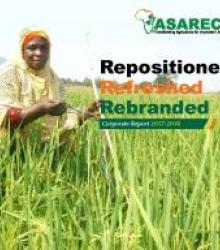| elibrary image | Title | Author | elibrary Type | Keywords | Asbract |
|---|---|---|---|---|---|
| Status of human resource capacity for agricultural innovation in ASARECA national agricultural research systems | ASARECA | Presentations | The study targeted 6 countries in the ASARECA region: Burundi, Democratic Republic of Congo, Eritrea, Madagascar, Rwanda and south Sudan. Within those countries the target organisations were national agricultural research institutes, agricultural universities (public and private) and private research companies/ institutes where they exist. The study assesses the human and institutional capacity on the ground, looks at the overall environment, including infrastructure that supports research, and makes several conclusions and recommendations. |
||
| Ethiopia, Kenya, Tanzania and Uganda Use Science and Technology to Boost Agricultural Productivity | ASARECA | Presentations |
|
||
| Gender Mainstreaming to Support Agricultural Development for Improved Livelihoods Best Practices in Eastern and Southern Africa | Adeline R. Muheebwa, Yeshi Chiche | Presentations | In December 2012, the programme on Sustainable Intensification of Maize-Legume cropping systems for food security in Eastern and Southern Africa (SIMLESA) commissioned a study to compile case studies of good practices in gender mainstreaming in the areas covered by the programme. This study was a result of an action point agreed on by participants at a Gender Mainstreaming Training Workshop held in July 2011 in Morogoro, Tanzania. The compilation of the case studies of good practices was intended to take stock and showcase the efforts of gender mainstreaming in the SIMLESA programme that had started three years earlier. The assignment had three major tasks: (1) to review the case studies collected by the SIMLESA programme staff to determine the potential for generation of gender responsive case studies; (2) to conduct field visits to the five countries (Ethiopia, Kenya, Malawi, Mozambique, Tanzania) and collect additional gender data/information on the case studies, to ensure that the case studies are comprehensive in demonstrating the gender concerns/issues from various countries; and (3) to compile at least five case studies for each country, highlighting the change resulting from (or impact of) the gender mainstreaming efforts of the SIMLESA programme. |
||
| End of Phase 1 EAAPP (East Africa Agriculture Productivity Programme) report | Kate Wellard, Tim Chancellor, Geresom Okecho, Sheba Ndagire and Stephen Mugarura | Presentations | An ambitious regional programme, the Eastern Africa Agricultural Productivity Programme (EAAPP), which ASARECA has been coordinating for the last five years, has posted impressive impacts, prompting a call for immediate roll-out of a second phase. |
||
| Communication Strategy for sharing EAAPP innovations | ASARECA | Presentations | Effective communication was critical to the attainment the objectives of the Eastern Africa Agricultural Productivity Program (EAAPP). For the commodity-based Centres of Excellence, to benefit the region, knowledge and information must be communicated and shared across national boundaries. This was basis on with the East African Agricultural Productivity Strategy and Implementation Plan was developed. The Communication Strategy contributes directly to the EAAPP purpose of enhancing regional communication and information sharing by EAAPP and the regional centres of excellence. |
||
| Eastern Africa Fall Armyworm Management Strategy and Implementation Plan | Brian Isabirye, Mathew Abang, Solomon Gelalcha and Winfred Hammond | Presentations | The invasive fall armyworm (FAW), or Spodoptera frugiperda, is a pest ravaging crops in over 44 African countries. It is native to the Americas, but recently spread to Africa, with its occurrence first reported in West and Central Africa in early 2016. It spread to southern Africa in late 2016, and by early 2017 was confirmed in East Africa (FAO, 2017). FAW attacks more than 80 different plant species including maize, a major food staple in sub-Saharan Africa, upon which more than 300 million people depend. If FAW is not effectively controlled, it is expected to cause a US$3bn loss to maize in Africa along with serious food shortages in the next year (IAPPS, 2017). |
Search
Presentations
Copyright © 2025. All rights reserved.
Designed By ASARECA


